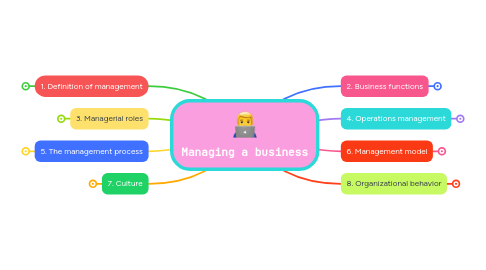
1. 1. Definition of management
1.1. Getting thing done through other people
1.2. Effective management
1.2.1. Power
1.2.2. Authority
1.2.3. Responsibility
1.2.4. Accountability
1.3. Type of manager
1.3.1. A line manager
1.3.2. A staff manager
1.3.3. A function manager
1.3.4. A project manager
1.4. The management hierarchy
1.4.1. Top managers
1.4.2. Middle managers
1.4.3. First - line managers
1.4.4. Direct operational staff
2. 3. Managerial roles
2.1. The informational role
2.2. The interpersonal role
2.3. The decisional role
2.3.1. Allocate resources
2.3.2. Handle disturbances
2.3.3. Negotiate
2.3.4. Solve problems
2.3.5. Act as entrepreneur
3. 5. The management process
3.1. Planning
3.2. Organizing
3.3. Controlling
3.4. Leading
3.5. Puting the management process into action
4. 7. Culture
4.1. Robert E Quinn - type of culture
4.1.1. The Tension between having flexibility and control
4.1.2. The tension between whether the business is inward - or outward - looking
4.2. Types
4.2.1. Internal process culture
4.2.2. Rational goal culture
4.2.3. Open systems culture
4.2.4. Human relations culture
5. 2. Business functions
5.1. Operations or production
5.2. Finance
5.3. Marketing management
5.3.1. Consumer markets
5.3.1.1. Fast-moving consumer goods
5.3.1.2. Consumer durables
5.3.1.3. Services
5.3.2. Industrial markets
5.3.3. The marketing mix and segmentation
5.3.3.1. Marketing mix
5.3.3.2. Marketing segmentation
5.3.4. Marketing orientation and its alternative
5.3.5. Product
5.3.5.1. Basic product
5.3.5.2. Actual product
5.3.5.3. Augmented product
5.3.6. Price
5.3.7. Place
5.3.7.1. Producer → consumer
5.3.7.2. Producer→ wholesalers→ retailers → consumer
5.3.8. Promotion
5.3.8.1. Type of promotion
5.3.8.2. Promotion technicques (Push and pull)
5.3.9. The effect of technology
5.4. Human resource management
5.4.1. Work
5.4.1.1. personnel planning and control
5.4.1.2. JD
5.4.1.3. Development of policies
5.4.1.4. Development of training courses
5.4.1.5. Designing remuneration packages and drawing up employment contracts
5.4.1.6. Considering the impact or interacting with the organization
5.4.2. Different approaches to HRM
5.4.2.1. The hard approach
5.4.2.2. The soft approach
5.4.2.2.1. Short - term
5.4.2.2.2. Long - term
5.4.3. The Harvard four Cs model of HRM
5.4.3.1. Commitment
5.4.3.2. Competence
5.4.3.3. Congruence
5.4.3.4. Cost - effectiveness
5.4.4. The effect of technology
5.4.4.1. Intelligent systems
5.4.4.2. Artificial intelligence
5.5. IT management
5.5.1. Monitoring
5.5.2. Planning
5.5.3. Structure
5.5.4. Staffing and skills
6. 4. Operations management
6.1. Research and development ( R&D)
6.1.1. Pure research
6.1.2. Applied research
6.1.3. Development
6.2. Procurement
6.2.1. Quantity( time, cost of holding inventories)
6.2.2. Quality
6.2.3. Price
6.2.4. Lead time
6.3. Operations/production management
6.3.1. Volume
6.3.2. Variety
6.3.3. Variation in demand
6.3.4. Visibility
7. 6. Management model
7.1. Rational goal
7.1.1. Determine the one best way of doing a particular task
7.1.2. Select the best person to do this task on the basis of the mental and physical capabilities
7.1.3. Train the worker to follow the set procedure very precisely
7.1.4. give financial incentives to ensure the work is done in the prescribed way
7.1.5. Give all responsibility to plan and organize work to the manager, not to the worker
7.2. Internal process
7.2.1. Rationality
7.2.2. Hierarchical lines of authority
7.2.3. Detailed rules and procedures
7.2.4. Division of labour
7.2.5. Impersonality
7.2.6. Centralisation
8. 8. Organizational behavior
8.1. Delegation
8.1.1. Advantages
8.1.1.1. The manager can be relieved of less important activities
8.1.1.2. Team aspect is motivational
8.1.1.3. It brings together skills and ideals
8.1.1.4. It allows for career development and succession planning, etc....
8.1.2. Problems caused by poor delegation
8.1.2.1. Too much supervision can waste time and be demotivating for subordinate
8.1.2.2. Manger only delegates boring work
8.1.2.3. Manager tries to delegate full responsibility …. Etc
8.2. The organizational iceberg:
8.2.1. formal aspects:
8.2.2. Behavior aspect
8.3. Models of human behavior
8.3.1. Taylor's model:
8.3.1.1. scientific management
8.3.2. Theory X & theory Y
8.3.2.1. Theory X: individuals dislike work, avoid, lack ambition, desire security,...
8.3.2.2. Theory Y: people like responsibility, rewards,...
8.4. Motivation
8.4.1. Maslow's content theory:
8.4.2. Hygiene and motivating factors
8.5. Group behavior
8.5.1. The usefulness of groups (for business, individual)
8.5.2. Stages group development: forming, storming, norming, performing
8.5.3. Team roles: Leader, Shaper, Plant, Evaluator, Resource-investigator, company worker, team worker, finisher.
8.6. Leadership style
8.6.1. Exploitative-authoritative
8.6.2. Benevolent-authoritative
8.6.3. Consultative
8.6.4. Participative
